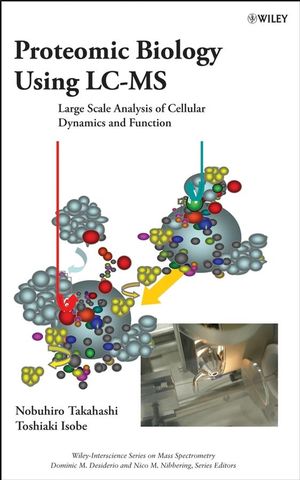Proteomic Biology Using LC/MS: Large Scale Analysis of Cellular Dynamics and FunctionISBN: 978-0-471-66258-7
Hardcover
272 pages
November 2007
 This is a Print-on-Demand title. It will be printed specifically to fill your order. Please allow an additional 15-20 days delivery time. The book is not returnable.
|
||||||
Chapter 1. Overview of Proteomics.
What is the proteomics?
1-2 Proteomic analysis using two-dimensional gel electrophoresis (2DE) and mass spectrometry .
1-2-1 Protein separations by 2DE.
1-2-2 Development of the technologies for protein identification .
1-2-3 The protein identification based on gel separation and mass spectrometry.
1-3 Strategies for characterizing an entire proteome and understanding the proteome function.
1-3-1 Modification-specific proteomics.
1-3-2 Activity-based profiling.
1-3-3 Sub-cellular (Organelle) proteomics.
1-3-4 Machinery [complex (interaction)] proteomics.
1-3-5 Dynamic proteomics.
Chapter 2. Proteomic Tools for Analysis of Cellular Dynamics.
2-1 LC-BASED PROTEOMICS TECHNOLOGIES.
2-1-1 LC system for peptide separation .
LC-MS interface.
ESI apparatus .
Micro- and nano-capillary columns.
Packing materials.
1D-LC system.
Application of 1D-LC-MS/MS to shotgun analysis of moderately complex protein mixtures.
Experimental example 2-1.
2D LC-MS system.
Experimental example 2-2.
2-1-2 Application of LC-MS methods to functional proteomics.
Sub-cellular (organelle) using a cell-surface modification reagent and cell fractionation.
Experimental example 2-3 .
Modification proteomics.
Phosphorylation site mapping.
Experimental example 2-4.
Glycosylation site mapping.
Experimental example 2-5.
Ubiquitinated protein identification by using ubiquitin-specific antibody .
Experimental example 2-6.
2-2 Development of quantitative proteomics.
2-2-1 Isotope labeling for quantitative analysis using MS.
in vivo labeling.
in vitro labeling.
2-2-2 Quantitation strategies for LC-MS analysis of isotope labeled peptide mixture and software for computer analysis.
2-2-3 Label free quantitation software.
2-2-4 Absolute quantitation.
Method using stable isotope labeled reference peptides.
Method without using internal standards.
Chapter 3. Dynamics of Functional Cellular Machinery: From Statics to Dynamics in Proteomic Biology.
From statics to dynamics in proteomic biology.
3-1 DYNAMIC ANALYSIS OF CELLULAR FUNCTION.
3-1-1 Strategy for dynamic analysis of cellular machineries (multi-protein complexes).
Approach collecting time dependent data.
Approach utilizing stage specific protein association.
3-1-2 Methods for the isolation of a cellular machinery/multi-protein complex.
Affinity-tag purification.
Affinity chromatography with an antibody- or a protein-immobilized column.
Immuno-affinity purification using antibody-fixed beads.
Experimental example 3-1.
Pull-down purification using immobilized protein beads.
Experimental example 3-2.
3-1-3 Cellular machinery (multi-protein complex).
3-2 Dynamics of Ribosome Biogenesis .
3-2-1 Snapshot Analyses of Preribosomal Particles in Yeast .
3-2-2 Snapshot Analyses of Preribosomal Particles in Mammals.
Experimental example 3-3.
3-2-3 Quantitative (dynamic) analysis using isotope labeled reagents.
Experimental example 3-4.
3-2-4 Orthogonal Comparison of the Process of Ribosome Biogenesis.
3-3 Dynamic analyses of Sub-cellular structures.
3-3-1 Proteome dynamics of the nucleolus.



